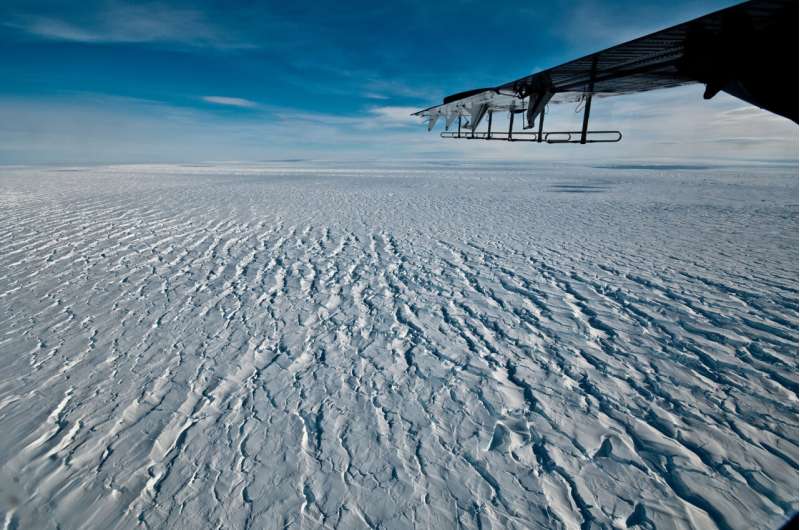
For decades, the ice shelf helping to hold back one of the fastest-moving glaciers in Antarctica has gradually thinned. Analysis of satellite images reveals a more dramatic process in recent years: From 2017 to 2020, large icebergs at the ice shelf's edge broke off, and the glacier sped up.
Since floating ice shelves help to hold back the larger grounded mass of the glacier, the recent speedup due to the weakening edge could shorten the timeline for Pine Island Glacier's eventual collapse into the sea. The study from researchers at the University of Washington and British Antarctic Survey was published June 11 in the open-access journal Science Advances.
"We may not have the luxury of waiting for slow changes on Pine Island; things could actually go much quicker than expected," said lead author Ian Joughin, a glaciologist at the UW Applied Physics Laboratory. "The processes we'd been studying in this region were leading to an irreversible collapse, but at a fairly measured pace. Things could be much more abrupt if we lose the rest of that ice shelf."
Pine Island Glacier contains approximately 180 trillion tons of ice—equivalent to 0.5 meters, or 1.6 feet, of global sea level rise. It is already responsible for much of Antarctica's contribution to sea-level rise, causing about one-sixth of a millimeter of sea level rise each year, or about two-thirds of an inch per century, a rate that's expected to increase. If it and neighboring Thwaites Glacier speed up and flow completely into the ocean, releasing their hold on the larger West Antarctic Ice Sheet, global seas could rise by several feet over the next few centuries.
These glaciers have attracted attention in recent decades as their ice shelves thinned because warmer ocean currents melted the ice's underside. From the 1990s to 2009, Pine Island Glacier's motion toward the sea accelerated from 2.5 kilometers per year to 4 kilometers per year (1.5 miles per year to 2.5 miles per year). The glacier's speed then stabilized for almost a decade.
Results show that what's happened more recently is a different process, Joughin said, related to internal forces on the glacier.
From 2017 to 2020, Pine Island's ice shelf lost one-fifth of its area in a few dramatic breaks that were captured by the Copernicus Sentinel-1 satellites, operated by the European Space Agency on behalf of the European Union. The researchers analyzed images from January 2015 to March 2020 and found that the recent changes on the ice shelf were not caused by processes directly related to ocean melting.
"The ice shelf appears to be ripping itself apart due to the glacier's acceleration in the past decade or two," Joughin said.
Two points on the glacier's surface that were analyzed in the paper sped up by 12% between 2017 and 2020. The authors used an ice flow model developed at the UW to confirm that the loss of the ice shelf caused the observed speedup.
"The recent changes in speed are not due to melt-driven thinning; instead they're due to the loss of the outer part of the ice shelf," Joughin said. "The glacier's speedup is not catastrophic at this point. But if the rest of that ice shelf breaks up and goes away then this glacier could speed up quite a lot."
It's not clear whether the shelf will continue to crumble. Other factors, like the slope of the land below the glacier's receding edge, will come into play, Joughin said. But the results change the timeline for when Pine Island's ice shelf might disappear and how fast the glacier might move, boosting its contribution to rising seas.
"The loss of Pine Island's ice shelf now looks like it possibly could occur in the next decade or two, as opposed to the melt-driven subsurface change playing out over 100 or more years," said co-author Pierre Dutrieux, an ocean physicist at British Antarctic Survey. "So it's a potentially much more rapid and abrupt change."
Pine Island's ice shelf is important because it's helping to hold back this relatively unstable West Antarctic glacier, the way the curved buttresses on Notre Dame cathedral hold up the cathedral's mass. Once those buttresses are removed, the slow-moving glacier can flow more quickly downward to the ocean, contributing to rising seas.
"Sediment records in front of and beneath the Pine Island ice shelf indicate that the glacier front has remained relatively stable over a few thousand years," Dutrieux said. "Regular advance and break-ups happened at approximately the same location until 2017, and then successively worsened each year until 2020."
Explore further
Citation: Pine Island Glacier's ice shelf is ripping apart, speeding up key Antarctic glacier (2021, June 11) retrieved 11 June 2021 from https://ift.tt/3gcxg5x
This document is subject to copyright. Apart from any fair dealing for the purpose of private study or research, no part may be reproduced without the written permission. The content is provided for information purposes only.
https://ift.tt/2Sl29vD
Science
No comments:
Post a Comment